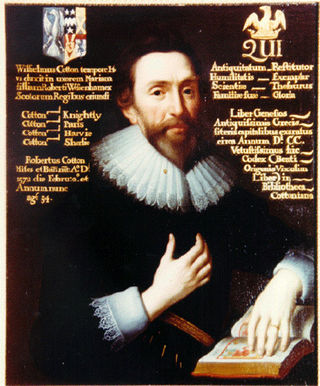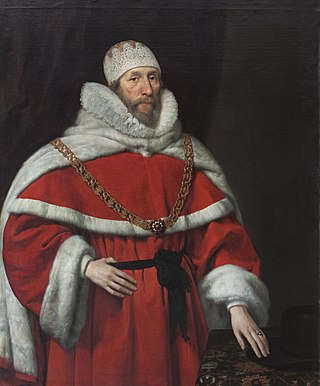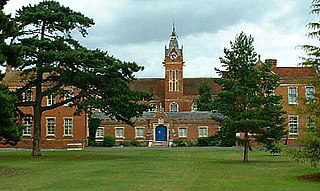Related Research Articles

There have been three Baronetcies created for persons with the surname Cotton, all in the Baronetage of England. One creation is extant as of 2008.

Sir Henry Hobart, 1st Baronet, of Blickling Hall, was an English politician who succeeded Sir Edward Coke to become Chief Justice of the Court of Common Pleas.
Sir Matthew Boynton, 1st Baronet was an English landowner and politician who sat in the House of Commons in two parliaments between 1621 and 1647. He supported the Parliamentary cause in the English Civil War.

There have been five baronetcies created for members of the old established family of Peyton of Peyton Hall in the parish of Boxford in Suffolk, all of whom were descended from Sir Robert Peyton of Isleham in Cambridgeshire, grandson and heir of Thomas Peyton (1418–1484) of Isleham, twice Sheriff of Cambridgeshire and Huntingdonshire, in 1443 and 1453. All the baronetcies are extinct.

Sir Heneage Finch was an English lawyer, Member of Parliament, and politician who sat in the House of Commons at various times between 1607 and 1626. He was Speaker of the English House of Commons in 1626.
Sir Francis Russell, 2nd Baronet was a Member of Parliament and a soldier for the parliamentary cause during the English Civil War. During the Interregnum he held several positions including membership in Cromwell's House of Lords.
Sir Christopher Wray was an English politician who sat in the House of Commons at various times between 1614 and 1646. He supported the Parliamentary cause in the English Civil War.
Sir Miles Sandys, 1st Baronet was an English landowner and politician who sat in the House of Commons at various times between 1614 and 1629.

Sir Thomas Puckering, 1st Baronet was an English landowner, courtier and politician who sat in the House of Commons at various times between 1621 and 1629.
Sir John Cutts was an English politician who sat in the House of Commons variously between 1604 and 1640.

Sir Gilbert Hoghton, 2nd Baronet was an English politician who sat in the House of Commons variously between 1614 and 1640. He was a Royalist leader during the English Civil War.
Sir John Peyton, 1st Baronet was an English politician who sat in the House of Commons at various times between 1593 and 1611.
Sir William Ayloffe, 1st Baronet, of Braxted Magna in Essex, was knighted by James I in 1603, created a baronet in 1612 and sat as a Member of Parliament (M.P.) from 1621 to 1622.
Sir Richard Worsley, 1st Baronet, was an English landowner and politician who sat in the House of Commons between 1614 and 1621.
Sir Drue Drury, 1st Baronet was an English landowner and politician who sat in the House of Commons between 1621 and 1624.
Sir Nicholas Throckmorton or Carew was an English landowner and politician who sat in the House of Commons in two parliaments between 1601 and 1622.

Sir John Coryton, 1st Baronet was an English politician who sat in the House of Commons from 1660 to 1680.

Sir Nicholas Carew, 1st Baronet, of Beddington, near Croydon was a landowner and Whig politician who sat in the House of Commons between 1708 and 1727.
Sir Rushout Cullen, 3rd Baronet (1661–1730), of Upton, Ratley, Warwickshire and Isleham, Cambridgeshire, was an English landowner and Whig politician who sat in the English and British House of Commons between 1697 and 1710.

Thomas Peyton (1418–1484) of Isleham, Cambridgeshire, was twice Sheriff of Cambridgeshire and Huntingdonshire, in 1443 and 1453. He rebuilt the church of St Andrew's in Isleham, in the chancel of which survives his monumental brass. He is depicted in a 1485 stained glass window in Long Melford Church, Suffolk, where he displays on his surcoat the Peyton arms: Sable, a cross engrailed or a mullet in the first quarter argent.
References
- 1 2 3 4 George E. Cokayne Complete Baronetage, Vol. 1 (1900)
- ↑ "Peyton, Edward (PTN618E)". A Cambridge Alumni Database. University of Cambridge.
- ↑ Willis, Browne (1750). Notitia Parliamentaria, Part II: A Series or Lists of the Representatives in the several Parliaments held from the Reformation 1541, to the Restoration 1660 ... London. pp. 229–239.